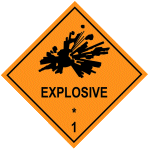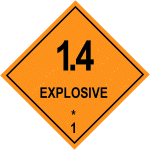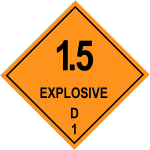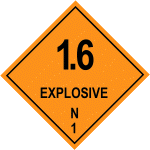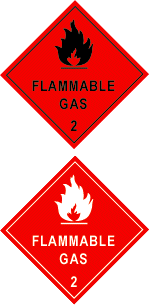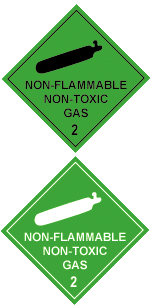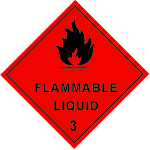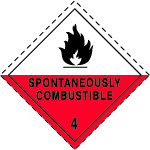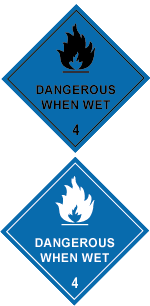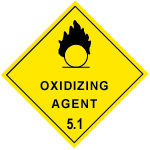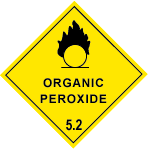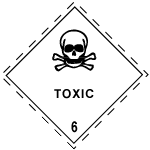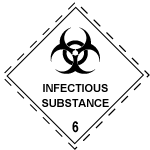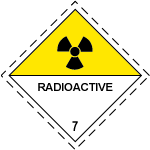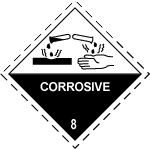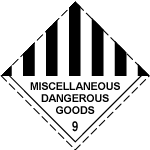OHS practices - Hazardous substances
Dangerous goods
Dangerous goods can be divided into nine classes, which in turn can be divided into sub-classes according to the nature of the hazard.
The following table identifies a description and example, and the associated label, for each class of dangerous goods.
| Class | Description and Examples | Label |
|---|---|---|
| 1 | The Explosives class is sub-divided into six hazard divisions: |
|
| 1.1 | Substances and articles that have a mass explosion hazard - a mass explosion being one that affects almost the entire load virtually instantaneously. |
|
| 1.2 | Substances and articles that have a projection hazard but not a mass explosion hazard. |
|
| 1.3 | Substances and articles that have a fire hazard and either a minor blast hazard or a minor projection hazard or both, but not a mass explosion hazard. This includes substances that give rise to considerable radiant heat, or that burn one after another, producing minor blast or projection effects or both. |
|
| 1.4 | Substances and articles that present no significant hazard. This class includes substances and articles that present only a small hazard in the event of ignition or initiation during transport. The effects of ignition or initiation are largely confined to the package and no projection of fragments of appreciable size or range is to be expected. An external fire should not cause virtually instantaneous explosion of almost the entire contents of the package. |
|
| 1.5 | Very insensitive substances that have a mass explosion hazard. These substances have a mass explosion hazard but are so insensitive that there is very little probability of initiation or of transition from burning to detonation under normal conditions of transport. |
|
| 1.6 | Extremely insensitive articles that do not have a mass explosion hazard. These articles contain only extremely insensitive detonating substances and demonstrate a negligible probability of accidental initiation or propagation. |
|
| 2 | Gases are sub-divided as follows, based on the primary hazard of the gas during transport: |
|
| 2.1 | Flammable gases that, at 20°C and at a standard pressure of 101.3 kPa, either:
Examples: propane, LPG |
|
| 2.2 | Non-flammable non-toxic gases comprise gases that are transported at a pressure not less than 20kPa at 20°C, or as refrigerated liquids, and that:
Examples: nitrogen, helium, compressed air, krypton, bromotrifluoromethane |
|
| 2.3 | Toxic gases comprise gases that:
Examples: chlorine, phosgene gas, hydrogen cyanide, ammonia |
|
| 3 | Flammable liquids are liquids or mixtures of liquids containing solids in solution or suspension that give off a flammable vapour at a temperature not more than 60.5°C, closed cup test, or not more than 65.6°C, open cup test, normally referred to as the flash point. |
|
| 4 | Flammable solids; substances liable to spontaneous combustion; and substances that in contact with water emit flammable gases. |
|
| 4.1 | Flammable solids comprises:
Examples: safety matches, mothballs, camphor, firelighters |
|
| 4.2 | Substances that are liable to spontaneous combustion comprises substances that are liable to spontaneous heating under normal conditions encountered in transport; or to heating up in contact with air, and being then able to catch fire. |
|
| 4.3 | Substances that in contact with water emit flammable gases comprises substances that, by interaction with water, are liable to become spontaneously flammable or to give off flammable gases in dangerous quantities. |
|
| 5 | Oxidizing substances and organic peroxides. This class is sub-divided as follows: |
|
| 5.1 | Oxidizing substances comprises substances that, while in themselves are not necessarily combustible, may, generally by yielding oxygen, cause, or contribute to, the combustion of other material. |
|
| 5.2 | Organic peroxides comprise organic substances that contain the bivalent -0-0- structure and may be considered derivatives of hydrogen peroxide, where one or both of the hydrogen atoms have been replaced by organic radicals. Organic peroxides are thermally unstable substances that may undergo exothermic self-accelerating decomposition. In addition, they may have one or more of the following properties:
Examples: benzoyl peroxide, di-tert-butyl peroxide |
|
| 6 | Toxic and infectious substances. This class is sub-divided as follows: |
|
| 6.1 | Toxic substances comprises substances liable either to cause death or serious injury or to harm human health if swallowed or inhaled or by skin contact. |
|
| 6.2 | Infectious substances are those substances known or reasonably expected to contain pathogens. |
|
| 7 | Radioactive materials are defined as any material for which the specific activity is greater than 70 kBq/kg. |
|
| 8 | Corrosive substances are substances that, by chemical action, will cause severe damage when in contact with living tissue, or, in the case of leakage, will materially damage, or even destroy, other goods or the means of transport; they may also cause other hazards. |
|
| 9 | Miscellaneous dangerous goods and articles comprises substances and articles that during transport present a danger not covered by other classes, and include substances that are transported or offered for transport at temperatures equal to or exceeding 100°C in a liquid state or at temperatures equal to or exceeding 240°C in the solid state. |
|




